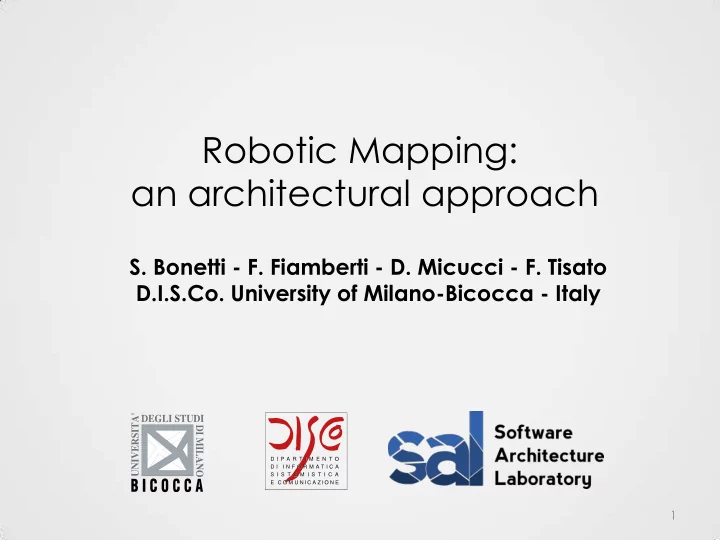

Robotic Mapping: an architectural approach S. Bonetti - F. Fiamberti - D. Micucci - F. Tisato D.I.S.Co. University of Milano-Bicocca - Italy D I P A R T I M E N T O D I P A R T I M E N T O D I D I I N F O R M A T I C A I N F O R M A T I C A S I S T E M I S T I C A S I S T E M I S T I C A E C O M U N I C A Z I O N E E C O M U N I C A Z I O N E 1
The problem Building an environment map by means of a mobile entity based on low-cost sensors Low-cost sensors have limited accuracy, precision and efficiency 2
Our idea • Use of multiple, heterogeneous sensors • «smart» management of sensor activations in a context-aware approach 3
Our approach • Our idea has been reified in a modular architecture which carefully separates the activities of: Sensing Integration Planning Control 4
Our prototype • Directionable Laser Range Finder • RGB Camera 5
Sensor Component It contextualizes data produced by the associated physical sensor as an occupancy map ActivityInitial Data Real environment Occupancy map Acquisition Raw Data ActivityFinal Map Update cell i j = P H sn SOM SOM: Sensor Occupancy Map 6
Sensor Component Laser orientation Entity frame of reference ActivityInitial Data Acquisition World frame of reference Raw Data ActivityFinal Map Update SOM 7
Sensor Component ActivityInitial Data Acquisition Raw Data ActivityFinal Edge Map Update Camera FOV SOM Entity frame of reference World frame of reference 8
World Map Builder It integrates and fuses environment representations from different sensors producing a single environment map WOM (World Occupancy Map) generated by fusing several SOM s 9
Application Strategy It implements the application strategy for the map construction WRM (World Relevance Map) Analysis & WOM WRM Planning Low relevance High relevance 10
SAP (Sensor Activity Planner) It manages the activation of the associated sensor by evaluating a trade-off between activation costs and benefits. SCM (Sensor Cost Map) – It spatially contextualizes the computational cost (either static or dynamic) of activations of the associated sensor Camera FOV Infinite cost Low cost High cost 11
SAP (Sensor Activity Planner) SAM (Sensor Attractiveness Map) – It defines the areas that must be analyzed by the associated sensor Attractive cell 12
SAP (Sensor Activity Planner) SC SAP SAM Analysis SAM Identification of WRM Interesting Areas SCM WRM SOM Data Acquisition * Grid Cell Coordinate Raw Data Sensor Activity SCM Map Update Planification SOM SAM 13
Virtual SC ActivityInitial ActivityInitial SAM Analysis SAM Analysis SAM SAM Data Acquisition SOM Analysis and Processing SOM Raw Data Map Update Map Update SOM SOM SCM SCM ActivityFinal ActivityFinal Sensor Component Virtual Sensor Component 14
Complete architecture Application Strategy WRM WOM Sensor Sensor Sensor World Activities Activities Activities … … Map Builder Planner Planner Planner SAM SCM SOM SAM SCM SOM SAM SCM SOM Virtual Sensor Sensor … … Sensor Component Component Component 15
A first implementation Application Strategy WRM WOM Sensor Sensor World Activities Activities Map Builder Planner Planner SAM SCM SOM SAM SCM SOM Sensor Sensor Component Component 16
A concrete example WOM WRM Start-up situation Laser SOM Camera SOM 17
A concrete example WOM WRM Activation of both sensors and update of the corresponding SOMs Laser SOM Camera SOM 18
A concrete example WOM WRM Update of the world model and relevance map Laser SOM Camera SOM 19
A concrete example WOM WRM Activation of the laser sensor Laser SOM Camera SOM 20
A concrete example ? WOM WRM Update of the world model and choice of a new strategy Laser SOM Camera SOM 21
Conclusions and comments • The proposed architecture is: – Scalable – Modular – Open – Independent of application strategies • Future developments: – Extensive experimentations – Integration with additional sensor typologies – Application to real-life cases 22
23
Questions & Answers Q1 : what are the problems of software development in robotics that can be • considered "solved"? Allowing for the application of low-cost/low-performance sensors to the problem of robotic mapping. In fact, such a problem is known to involve large amounts of data to be elaborated and fused. Q2 : what are the solutions to these problems that can be considered best • practice and why? Separation of concerns, which allows to dominate the problem’s complexity by decomposing the system in sub-components. Q3 : to what extent the solutions to these problems are robotic-specific? • The approach is general and should be used every time a system is made of multiple activities. The specific approach is aimed at solving a robotic-specific issue. 24
Questions & Answers Q4 : what problems of software development in robotics remain to be solved? • The definition of a sensible strategy for every decisional component. Q5 : why state-of-the art software technology is not adequate to solve these • problems? To the knowledge of the authors, no solutions to the robotic mapping problem exist which exploit both an architectural approach and the use of low-cost sensors. Q6 : what are the promising research directions to solve the open problems? • Performing thorough experimentations to test the validity of the approach and devise correct strategies for the decisional components. 25
Recommend
More recommend